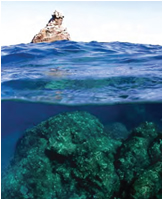Hānau Moku – The Birth of the Islands
 Birth - creation - is a central pillar of traditional cultures across the globe. In Native Hawaiian culture, human life comes not only from two biological parents, but from a complex spiritual and literal genealogy that ties humans with a bond of kinship to everything else, both living and non-living, in the natural world. Pō, the primordial female darkness from which all life springs and to which it returns after death, is seen as giving birth to the world, its natural components, all of the Hawaiian gods, and humans. The union of her progeny, Kumulipo and Pō‘ele, gives rise to all the creatures of the world, beginning in the oceans with the coral polyp - a genealogy that, like current theories of evolution, starts with the simplest known life form and moves to the more complex. Native Hawaiians view the rising of magma from deep within the earth as the birthing of the islands - the physical manifestation of the union between the earth mother, Papahānaumoku (literally, “goddess who gives birth to the islands”), and the sky father, Wākea. The symbolism of this union is also the foundation for the name of the property: Papahānaumokuākea. In the Native Hawaiian culture, kūpuna (elders, or ancestors) are accorded reverence and respect, and are looked to as teachers by right of their greater experience. Native Hawaiians consider the islands of Papahānaumokuākea (also called the Kūpuna Islands in recent times) to be their kūpuna. Each island is a teacher, and each island has its own unique story and message. As the younger generation, humans are tasked to mālama (care for) the kūpuna. It is also humankind’s kuleana (responsibility) to take the time to listen to their wisdom.
Birth - creation - is a central pillar of traditional cultures across the globe. In Native Hawaiian culture, human life comes not only from two biological parents, but from a complex spiritual and literal genealogy that ties humans with a bond of kinship to everything else, both living and non-living, in the natural world. Pō, the primordial female darkness from which all life springs and to which it returns after death, is seen as giving birth to the world, its natural components, all of the Hawaiian gods, and humans. The union of her progeny, Kumulipo and Pō‘ele, gives rise to all the creatures of the world, beginning in the oceans with the coral polyp - a genealogy that, like current theories of evolution, starts with the simplest known life form and moves to the more complex. Native Hawaiians view the rising of magma from deep within the earth as the birthing of the islands - the physical manifestation of the union between the earth mother, Papahānaumoku (literally, “goddess who gives birth to the islands”), and the sky father, Wākea. The symbolism of this union is also the foundation for the name of the property: Papahānaumokuākea. In the Native Hawaiian culture, kūpuna (elders, or ancestors) are accorded reverence and respect, and are looked to as teachers by right of their greater experience. Native Hawaiians consider the islands of Papahānaumokuākea (also called the Kūpuna Islands in recent times) to be their kūpuna. Each island is a teacher, and each island has its own unique story and message. As the younger generation, humans are tasked to mālama (care for) the kūpuna. It is also humankind’s kuleana (responsibility) to take the time to listen to their wisdom.
